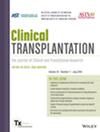Currently, there is little evidence on the prevalence and factors associated with sarcopenia risk or frailty risk in patients post heart transplantation (HTx). The objective of this study was to analyze the influence of sociodemographic, lifestyle, physical, and psychological factors on sarcopenia and frailty risk in patients post-HTx.
133 patients post-HTx (59.4% men, mean age 56.5 ± 12.7 years) participated in this cross-sectional study. The main outcomes were sarcopenia and frailty risk, and potential related predictors were comorbidities, time from transplantation, body mass index, sociodemographic factors, musculoskeletal pain, functional capacity, kinesiophobia, sleep problems, depression, physical activity, and diet quality. Multiple regression models were performed with all predictors, including polynomial regressions for predictors with a nonlinear relationship.
The predictor variables explained 73.93% of frailty's variance. Functional capacity (with a nonlinear relationship) and diet quality were significant predictors of frailty risk, while diabetes and physical activity were marginally significant. In addition, the predictors explained 73.52% of sarcopenia's variance. Diabetes, functional capacity (with a nonlinear relationship), and kinesiophobia were significant predictors of sarcopenia risk, while pain intensity and diet quality were marginally significant.
Multivariate analysis conducted on patients post-HTx revealed that functional capacity was associated with both sarcopenia and frailty risk. Additionally, diet quality was a predictive factor of frailty, while diabetes and kinesiophobia were predictors of sarcopenia. These findings emphasize the importance of proper management to prevent frailty and sarcopenia, which share common associated factors.


